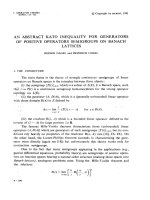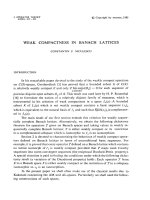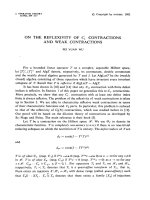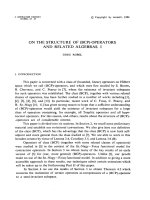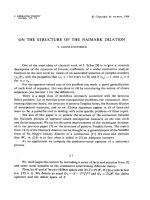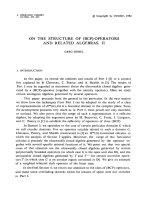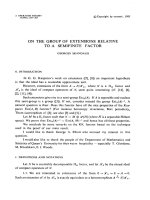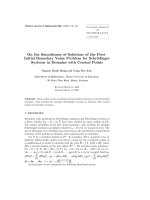Báo cáo toán học: "On the Continuity of Julia Sets and Hausdorff Dimension of Polynomials" ppsx
Bạn đang xem bản rút gọn của tài liệu. Xem và tải ngay bản đầy đủ của tài liệu tại đây (122.49 KB, 7 trang )
Vietnam Journal of Mathematics 33:3 (2005) 283–289
On the Continuity of Julia Sets and
Hausdorff Dimension of Polynomials
Zhuang Wei
Institute of Mathematics, Chinese Academy of Sciences,
Beijing, 100080, China,
Received March 5, 2004
Revised April 22, 2005
Abstract. We study the continuity of Julia set of some rational maps and the stability
of the Hausdorff dimension of the Julia set of polynomials
z
d
+ c (d ≥ 2)forsome
semi-hyperbolic parameters
c in the boundary of the generalized Mandelbrot set.
1. Introduction and Main Results
We say rational maps f
n
converge to f algebraically if degf
n
=degf and, when f
n
is expressed as the quotient of two polynomials, the coefficients can be chosen to
converge to those of f .Equivalently,f
n
→ f uniformly in the spherical metric.
Recall that compact sets K
n
→ K in the Hausdorff topology if
(1) Every neighborhood of a point x ∈ K meets all but finitely many K
n
;and
(2) If every neighborhood of x meets infinitely many K
n
,thenx ∈ K.
We define lim inf K
n
as the largest set satisfying (1), and lim sup K
n
as
the smallest set satisfying (2). Then K
n
→ K is equivalent to lim sup K
n
=
lim inf K
n
= K.
J
c
denotes the Julia sets of polynomials P
c
= z
d
+ c and let M
d
= {c|J
c
is connected} be the connectedness locus; for d = 2 it is called the Mandelbrot
set and HD denotes the Hausdorff dimension.
In this paper we study the stability of the Hausdorff dimension of polynomials
P
c
= z
d
+ c, d ≥ 2, such that the critical point 0 is not recurrent and 0 ∈ J
c
.
These polynomials are semi-hyperbolic in the sense of [3].
Let J(f) be the Julia sets of rational maps f. Recall that the equilibrium
measure μ(f)off supported in J(f) depends continuously on f; see [7]. n 0
284 Zhuang Wei
means for all n sufficiently large. We have the following theorems:
Theorem 1. Let f
n
→ f algebraically. Assume that f has no Siegel disc,
Herman ring nor parabolic cycles, then
J(f
n
) → J (f)
in the Hausdorff topology.
Theorem 2. Let P
c
0
= z
d
+ c
0
(d ≥ 2) be semi-hyperbolic. If there is B
1
=
B
1
(c
0
) > 0 such that for a sequence c
n
→ c
0
from the interior of M
d
,
dist (c
n
,∂M
d
) ≥ B
1
|c
n
− c
0
|
1+1/d
,
then HD(J
c
n
) → HD(J
c
0
).
2. Preliminaries
Definition 2.1. The definition of conformal measures for rational maps was
first given by Sullivan (see [6]) as a modification of the Patterson measures for
limit sets of Fuchsian groups. Let t>0. A probability measure m on J(f) is
called t-conformal for f :
C → C if
m(f(A)) =
A
|f
|
t
dm
for every Borel set A ⊂ J(f) such that f |
A
is injective.
A more general definition, showing the connection to ergodic theory, has
been given by Denker and Urba´nski earlier (see [9]). It follows from topological
exactness of f |
J(f)
that a conformal measure m is positive on non-empty sets
and therefore
M(r)=inf{m(B(z, r)) : z ∈ J(f)} > 0
for every r>0; see [8].
Consider c
0
∈ ∂M
d
so that P
c
0
is semihyperbolic, then all (finite) periodic
points of P
c
0
are repelling. Moreover, the set ω(0) of accumulation points of the
orbit of 0 is a hyperbolic set of P
c
0
. Thus by the expansive property, there is
m>1 such that P
m
c
0
(0) ∈ ω(0). We suppose m>1 is the least integer with this
property, usually set z
0
= P
m
c
0
(0).
In [3] it is proved that there are constants ε>0, B
0
> 0andθ ∈ (0, 1) such
that for all x ∈ J
c
0
and any connected component V of P
−n
c
0
(V
ε
(x)) for n ≥ 0,
the map P
n
c
0
: V → V
ε
(x) has degree at most d and diam(V )<B
0
θ
n
.Moreover
the complement of J
c
0
is a John domain; this means that J
c
0
is locally connected
and there is δ>0 such that if z ∈ J
c
0
and w belongs to a ray landing at z,then
V
δ|z−w|
(w) ∩ J
c
0
= ∅. In particular, by Carath´eodory
,
s theorem, the map φ
−1
c
0
,
defined in C − D, extends continuously to ∂D, so every ray lands at some point
in J
c
0
.
Continuity of Julia Sets and Hausdorff Dimension of Polynomials 285
We construct a Markov partition for ω(0) with puzzles; a puzzle is a set
bounded by a finite number of (closures of ) rays and an equipotential. Recall
that by [3] all rays land at some point in J
c
0
. Puzzles are homeomorphic to a
disc. We have the following propositions; see [2].
Proposition 2.1. (Markov Partitions) There is a Markov partition for ω(0) with
puzzles. That is, there is a finite collection of disjoint puzzles U
i
,(i =1, 2, ),
that cover ω(0) so that P
c
0
is univalent in U
i
and if U
i
∩ P
c
0
(U
j
) = ∅,then
U
i
⊂ P
c
0
(U
j
).
Consider the Markov partition U
i
,(i =1, 2, ), given by the Proposition 2.1.
For n ≥ 0, the preimages of the sets U
i
under P
n
c
0
that intersect ω(0) are called
the nth step pieces of the Markov partition. Note that for n ≥ 1 the collection
of all the nth step pieces is a Markov partition; we call it a refinement of the
Markov partition U
i
,(i =1, 2, ).
Proposition 2.2. (Bounded Distortion Property). For any k ≥ 0 the distortion
of P
k
c
0
in each of the kth step pieces of the Markov partition is bounded by some
constant K, independent of k.
Since P
c
0
is uniformly expanding in ω(0) there is a holomorphic motion
j : B
σ
(c
0
) × ω(0) → C,forsomeσ>0, which is compatible with dynamics; see
[4]. This means that for each c ∈ B
σ
(c
0
)themapj
c
: ω(0) → C is injective and
for each z ∈ ω(0) the function c → j
c
(z) is holomorphic. Being compatible with
dynamics means that for every c ∈ B
σ
(c
0
)themapj
c
conjugates P
c
0
on ω(0) to
P
c
on j
c
(ω(0)).
Proposition 2.3. Consider a Markov partition U
a
, a ∈ A,ofω(0). Then there
is σ>0 and a holomorphic motion j : B
σ
(c
0
) ×
a∈A
U
a
→ C compatible with
dynamics. Moreover there is R>0 such that j(B
σ
(c
0
) ×
a∈A
U
a
) ⊂ B
R
(0).
3. Proof of the Theorems
In this section we prove the theorems; the proof is divided into 2 parts.
Let f, f
n
be rational functions. We have the following lemma; see [1].
Lemma 3.1. If f
n
→ f algebraically, then J(f) ⊂ lim inf J(f
n
).
Proof of Theorem 1. By assumption, f has no Siegel disc, Herman ring nor
parabolic cycles. Since f
n
→ f algebraically , it follows by Lemma 3.1 that
J(f) ⊂ lim inf J(f
n
). So to prove J(f
n
) → J(f), we need only show lim sup J(f
n
)
⊂ J(f). This amounts to showing, for each x ∈ F (f ) (the Fatou set of f ), there
exists a neighborhood U of x such that U ⊂ F (f
n
), ∀n 0. Since the Fatou set
is totally invariant, we can replace x with a finite iteration f
i
(x) at any stage of
the argument.
For each x ∈ F (f ), under iterating f
i
(x) converge to an attracting (super-
286 Zhuang Wei
attracting) fixed-point d of f .
Suppose d is attracting (super-attracting). Then this behavior persists under
algebraic perturbation of f . In fact there is a small neighborhood U of d such
that f
n
(U) ⊂ U, for all n 0. Thus U ⊂ F(f
n
). Choosing i such that
f
i
(x) ∈ U, from [1] there exists a neighborhood of x persisting in the Fatou set
for large n.
Therefore the original sequence satisfies
J(f
n
) → J(f).
The proof of Theorem 1 is complete.
Proof of Theorem 2. Since P
c
0
is semi-hyperbolic, it follows by [2] that there
exists exactly one conformal measure μ in J
c
0
which has exponent d
c
0
= HD(J
c
0
)
or is atomic, supported in {P
−n
c
0
(0)}
n≥0
.(μ is not atomic if the measure μ of
a point is zero). For c
n
∈ M
d
, there is a unique conformal probability measure
μ
c
n
for P
c
n
supported in J
c
n
which has exponent d
c
n
= HD(J
c
n
)orisanatomic
measure living on the inverse orbit of the critical point if 0 is in J
c
n
; see [1, 6].
Thus to prove that
lim
n→∞
HD(J
c
n
)=HD(J
c
0
)
it is enough to prove that
lim
r→0n
lim
→∞
μ
c
n
(V
r
(0)) = 0.
In fact, if μ is any weak limit of {μ
c
n
}
n≥1
,thenμ is a conformal probability
measure supported in J
c
0
, by convergence of Julia sets. The previous limit
implies that the measure μ is not atomic at 0, so it has exponent d
c
0
and it
follows that d
c
n
→ d
c
0
.
Consider a Markov partition U
i
as in Sec. 2 and consider a holomorphic
motion j : V
σ
(c
0
) ×
U
i
→ C given by Proposition 2.3. Taking σ>0 small if
necessary we may assume that there are constants B
0
> 0andθ
0
∈ (0, 1) such
that for all m ≥ 1, all c ∈ V
σ
(c
0
)andallw ∈ j
c
(ω(0)), we have |(P
m
c
)
(w)|
−1
≤
B
0
θ
m
0
. We suppose that there is a uniform bounded distortion property: There
is a constant K>1 so that for every c ∈ V
σ
(c
0
), every k ≥ 1 and every kth step
piece W of the Markov partition j
c
(U
i
), the distortion of P
k
c
in W is bounded by
K.
Recall that U
n
is the nth step piece containing P
m
c
0
(0) ∈ ω(0) and Y
n
is the
pull-back of U
n
by P
m
c
0
containing 0. It follows that for r>0smallthereis
n = n(r) →∞,asr → 0sothatV
r
(0) ⊂ Y
c
n
for all c sufficiently close c
0
.Sowe
only need to prove that
lim
n→∞
lim
s→∞
μ
c
s
(Y
c
s
n
)=0.
Let D be a disc containing 0, small enough so that for c ∈ V
σ
(c
0
), P
m
c
|
D
is
at most of degree d. Refining the Markov partition if necessary, suppose that
U
c
1
⊂ P
m
c
(D) for all c ∈ V
σ
(c
0
).
For all n ≥ 1, we have
Continuity of Julia Sets and Hausdorff Dimension of Polynomials 287
μ
c
(Y
c
n
)=
l≥n
μ
c
(Y
c
l
− Y
c
l+1
).
From the Appendix 2 of [2], we have that z(c)=j
c
(c
0
) is the dynamical
continuation of the critical value c
0
and z
(c
0
) = 1. The function z is de-
fined in V
σ
(c
0
), it satisfies P
m−1
c
(z(c)) = j
c
(P
m−1
c
0
(c
0
)). For c ∈ B
σ
(c
0
)let
ξ(c)=j
c
(P
m−1
c
0
(c
0
)) = P
m−1
c
(z(c)) and put β
c
= P
m
c
(0). For l ≥ 1wehave
μ
c
(Y
c
l
− Y
c
l+1
) ≤ dμ
c
(U
c
l
− U
c
l+1
)inf
(Y
c
l
−Y
c
l+1
)∩J
c
|(P
m
c
)
(z)|
−d
c
.
By the uniform Bounded Distortion Property and considering that μ
c
is a prob-
ability measure, we have
μ
c
(U
c
l
− U
c
l+1
) ≤ K
d
c
|(P
l
c
)
(ξ(c))|
−d
c
.
On the other hand there is B
1
> 0 such that for all c ∈ V
σ
(c
0
)andz ∈ Y
c
1
,
|(P
m
c
)
(z)| >B
1
|P
m
c
(z) − β
c
|
(d−1)/d
. (*)
Let k = k(c) be the greatest integer such that β
c
∈ U
c
k
.Letl ≥ 1. Then there
are the following cases:
(1): k − 1 ≤ l ≤ k + 1. By the uniform Bounded Distortion Property and
Appendix 2 of [2], we have
|(P
l
c
)
(ξ(c))|
−1
∼|ξ(c) − β
c
|∼|z(c) − c|∼|c − c
0
|,
with implicit constants independent of c ∈ V
σ
(c
0
). Hence |(P
l
c
)
(ξ(c))|
−1
≤
B
2
|c − c
0
| for some B
2
> 0 independent of c. It follows by [2] that ∂M
d
and
J
c
0
are similar near c
0
; this implies that the local structure of ∂M
d
and J
c
0
are
similar near c
0
. On the other hand
dist(β
c
, (U
c
l
− U
c
l+1
) ∩ J
c
) ≥ dist(β
c
,J
c
) ≥ B
3
dist(c, J
c
) ≥ B
3
dist(c, J
c
0
)
≥ B
4
dist(c, ∂M
d
).
So for all z ∈ (Y
c
l
− Y
c
l+1
) ∩ J
c
|(P
m
c
)
(z)| >B
1
B
(d−1)/d
4
(dist(c, ∂M
d
))
(d−1)/d
,
thus
μ
c
(Y
c
l
− Y
c
l+1
) ≤ B
5
|c − c
0
|
d
c
(dist(c, ∂M
d
))
−d
c
(d−1)/d
,
where B
5
= d(KB
2
(B
1
B
(d−1)/d
4
)
−1
)
d
c
.
(2): l<k− 1. Note that
dist(β
c
,U
c
l
− U
c
l+1
) ≥ dist(∂U
c
l+1
,U
c
l+2
),
thus by the uniform Bounded Property,
dist(β
c
,U
c
l
− U
c
l+1
) >B
6
|(P
l
c
)
(ξ(c))|
−1
.
Hence by above (∗)wehave
288 Zhuang Wei
|(P
m
c
)
(z)| >B
1
(dist(β
c
,U
c
l
− U
c
l+1
))
(d−1)/d
≥ B
1
B
(d−1)/d
6
|(P
l
c
)
(ξ(c))|
−(d−1)/d
.
Therefore
μ
c
(Y
c
l
− Y
c
l+1
) ≤ dK
d
c
|(P
l
c
)
(ξ(c))|
−d
c
(B
1
B
(d−1)/d
6
)
−d
c
|(P
l
c
)
(ξ(c))|
d
c
(d−1)/d
.
Thus
μ
c
(Y
c
l
− Y
c
l+1
) ≤ B
7
θ
ld
c
/d
0
,
where B
7
= dK
d
c
(B
1
B
(d−1)/d
6
)
−d
c
B
d
c
/d
0
.
(3): l>k+1. We have dist(β
c
,U
c
l
−U
c
l+1
) ≥ B
8
dist(∂U
c
l−1
,U
c
l
). Thus reducing
B
6
> 0 if necessary, as in case (2), we have
dist(β
c
,U
c
l
− U
c
l+1
) >B
6
|(P
l
c
)
(ξ(c))|
−1
,
and μ
c
(Y
c
l
− Y
c
l+1
) ≤ B
7
θ
ld
c
/d
0
.
So we have
μ
c
(Y
c
n
)=
l≥n
μ
c
(Y
c
l
− Y
c
l+1
) ≤ B
5
|c − c
0
|
d
c
(dist(c, ∂M
d
))
−d
c
(d−1)/d
+ B
7
l≥n,l=k−1,k,k+1
θ
ld
c
/d
0
.
By our assumption, there are B
1
> 0 and a sequence c
n
→ c
0
from the
interior of M
d
such that dist(c
n
,∂M
d
) ≥ B
1
|c
n
− c
0
|
1+1/d
,thus,
B
1
(dist(c
n
,∂M
d
))
−1
≤|c
n
− c
0
|
(−1−
1
d
)
,
B
5
|c − c
0
|
d
c
(dist(c, ∂M
d
))
−d
c
(d−1)/d
≤ B
1
B
5
|c − c
0
|
d
c
|c − c
0
|
(−1−
1
d
)
d
c
(d−1)
d
≤ B
1
B
5
|c − c
0
|
d
c
d
2
.
Since
l≥n
θ
ld
c
/d
0
=
(θ
d
c
/d
0
)
n
1 − θ
d
c
/d
0
→ 0asn →∞,
we conclude that
lim
n→∞
lim
s→∞
μ
c
s
(Y
c
s
n
)=0,
the proof of theorem 2 is complete.
Open Question. I do not know any example satisfying the hypothesis of Theorem
2.
Acknowledgments. I am grateful to the referee and the editor for reading the first
version of this paper, and for very useful suggestions and comments. They help me to
improve this work.
Continuity of Julia Sets and Hausdorff Dimension of Polynomials 289
References
1. C. McMullen, Hausdorff dimension and conformal dynamics II: Geometrically
finite rational maps, Comment Math. Helv. 75 (2000) 535–593.
2. J. Rivera-Letelier, On the continuity of Hausdorff dimension of Julia sets and
similarity between the Mandelbrot set and Julia sets, Fund. Math. 170 (2001)
287–317.
3. L. Carleson, P. Jones, and J. -C. Yoccoz, Julia and John, Bol. soc. Brasil. Mat.
25 (1994) 1–30.
4. M. Shishikura, The Hausdorff dimension of the boundary of the Mandelbrot set
and Julia sets, Ann. Math. 147 (1998) 225–267.
5. M. Urba
´nski, Rational functions with no recurrent critical points, Ergod. Th.
and Dynam. Sys. 14 (1994) 391–414.
6. D. Sullivan, Conformal Dynamical Systems, In: Geometric Dynamics (Rio de
Janeiro, 1981), Lecture Notes in Math. 1007, Springer, Berlin, 1983, pp. 725–
752.
7. Fornaess-Sibony, Complex dynamics in higher dimensions, NATO Adv. Sci. Inst.
Ser. C. Math. Phys. Sci. 439 Complex potential theory (Montreal, PQ, 1993),
131-186, Kluwer Acad. Publ., Dordrecht, 1994.
8. M.Denker, and M.Urba´nski, On Hausdorff measures on Julia sets of subexpanding
rational maps, Israel J. Math. 76 (1991) 193–214.
9. M. Denker and M.Urba´nski, On Sullivan’s conformal measures for rational maps
of the Riemann sphere, Nonlinearity 4 (1991) 365–384.


